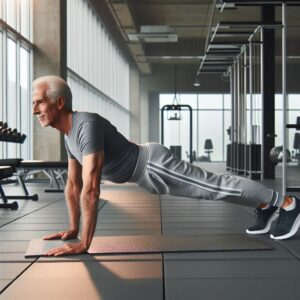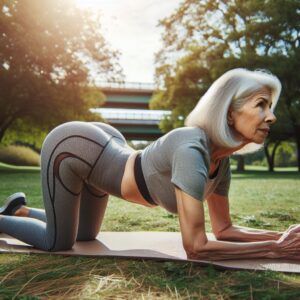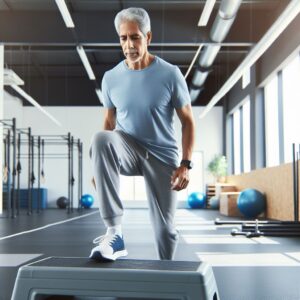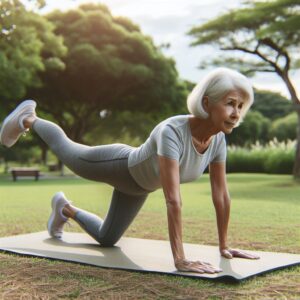Introduction
Falls are a significant concern for seniors, with statistics showing that one in four older adults experiences a fall each year. These falls can lead to severe physical injuries, emotional distress, and financial burdens. Therefore, fall prevention is crucial for maintaining the health and independence of seniors. One effective way to prevent falls is through regular exercise, particularly strength training and balance exercises. In this context, kettlebell exercises for seniors offer a unique and beneficial approach.
Understanding Kettlebells
What are Kettlebells?
Kettlebells are cast-iron or steel weights shaped like a ball with a handle. Originating from Russia in the 18th century, they have gained popularity worldwide for their versatility and effectiveness in strength training. Unlike traditional dumbbells, kettlebells allow for dynamic movements that engage multiple muscle groups simultaneously.
Benefits of Kettlebell Training
Kettlebell exercises for seniors provide numerous benefits. Firstly, they improve strength and balance, which are essential for fall prevention. Additionally, kettlebell training enhances coordination and flexibility, contributing to overall physical health. Moreover, these exercises offer cardiovascular benefits, promoting heart health and endurance.
Safety Considerations for Kettlebell Exercises for Seniors
Consulting with Healthcare Providers
Before starting any exercise program, seniors should consult with their healthcare providers. Medical clearance ensures that the exercises are safe and tailored to individual needs. This step is crucial for preventing injuries and maximizing the benefits of kettlebell exercises for seniors.
Proper Form and Technique
Maintaining correct posture and technique is vital when performing kettlebell exercises. Incorrect form can lead to injuries and reduce the effectiveness of the workout. Seniors should focus on proper alignment and avoid common mistakes, such as rounding the back or using excessive weight.
Choosing the Right Kettlebell
Selecting the appropriate kettlebell is essential for safe and effective training. Seniors should start with lighter weights and gradually increase as they build strength. Kettlebells come in various materials and handle designs, so choosing one that feels comfortable and secure is important.
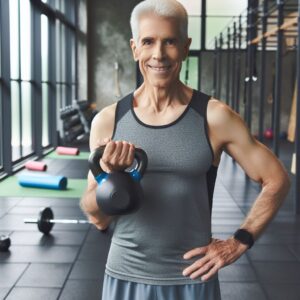
Essential Kettlebell Exercises for Seniors
Warm-Up Exercises
Before diving into kettlebell exercises, seniors should perform gentle stretches and mobility exercises. Warming up prepares the body for the workout, reducing the risk of injury and improving performance. Here are some effective warm-up exercises:
- Arm Circles: Stand with feet shoulder-width apart and extend your arms to the sides. Make small circles with your arms, gradually increasing the size of the circles. This exercise helps loosen the shoulder joints and improve mobility.
- Leg Swings: Hold onto a sturdy object for support and swing one leg forward and backward. Repeat with the other leg. Leg swings help warm up the hip joints and improve flexibility.
- Torso Twists: Stand with feet shoulder-width apart and place your hands on your hips. Twist your torso to the left and then to the right, keeping your hips facing forward. This exercise helps loosen the spine and improve rotational mobility.
Strength and Balance Exercises
Kettlebell Deadlift
The kettlebell deadlift is excellent for building lower body strength. It targets the hamstrings, glutes, and lower back, enhancing stability and balance. To perform this exercise, stand with feet hip-width apart, holding the kettlebell with both hands. Bend at the hips and knees, lowering the kettlebell to the ground, then return to the starting position. Here are some tips for performing the kettlebell deadlift:
- Keep Your Back Straight: Avoid rounding your back during the movement. Maintain a neutral spine to prevent injuries.
- Engage Your Core: Tighten your abdominal muscles to support your lower back and maintain stability.
- Use Controlled Movements: Perform the exercise slowly and with control to maximize the benefits and reduce the risk of injury.

Kettlebell Squat
Kettlebell squats enhance leg strength and stability, which is crucial for fall prevention. Hold the kettlebell close to your chest with both hands and stand with feet shoulder-width apart. Lower your body into a squat position, keeping your back straight and knees aligned with your toes, then return to standing. Here are some tips for performing the kettlebell squat:
- Keep Your Chest Up: Avoid leaning forward during the squat. Keep your chest lifted and your back straight.
- Push Through Your Heels: Focus on pushing through your heels as you return to the standing position. This helps engage the glutes and hamstrings.
- Maintain Proper Knee Alignment: Ensure that your knees are aligned with your toes and do not collapse inward during the squat.
Kettlebell Swing
The kettlebell swing improves hip strength and balance. Stand with feet shoulder-width apart, holding the kettlebell with both hands. Swing the kettlebell between your legs, then thrust your hips forward to swing it up to chest height. This dynamic movement engages the core and lower body. Here are some tips for performing the kettlebell swing:
- Use Your Hips: Focus on using your hips to generate the power for the swing, rather than relying on your arms.
- Keep Your Back Straight: Maintain a neutral spine throughout the movement to prevent injuries.
- Control the Descent: Control the kettlebell as it swings back down between your legs to avoid excessive strain on your lower back.
Kettlebell Farmer’s Walk
The kettlebell farmer’s walk builds grip strength and balance. Hold a kettlebell in each hand, standing tall with shoulders back. Walk forward, maintaining good posture and control. This exercise strengthens the entire body and improves stability. Here are some tips for performing the kettlebell farmer’s walk:
- Maintain Good Posture: Keep your shoulders back and your chest lifted as you walk.
- Engage Your Core: Tighten your abdominal muscles to support your spine and maintain stability.
- Take Controlled Steps: Walk slowly and with control to maximize the benefits and reduce the risk of injury.
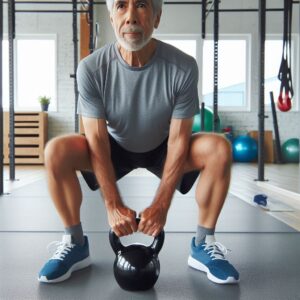
Kettlebell Halo
The kettlebell halo enhances shoulder mobility and core strength. Hold the kettlebell by the horns and circle it around your head, keeping your core engaged. This movement improves flexibility and coordination. Here are some tips for performing the kettlebell halo:
- Keep Your Core Engaged: Tighten your abdominal muscles to support your spine and maintain stability.
- Use Controlled Movements: Perform the exercise slowly and with control to maximize the benefits and reduce the risk of injury.
- Maintain Proper Alignment: Ensure that your shoulders and hips remain stable and do not twist during the movement.
Cool-Down Exercises
After completing the kettlebell exercises, seniors should perform gentle stretches and relaxation techniques. Cooling down helps reduce muscle soreness and promotes recovery. Here are some effective cool-down exercises:
- Hamstring Stretch: Sit on the floor with one leg extended and the other leg bent. Reach forward towards your toes, keeping your back straight. Hold the stretch for 20-30 seconds, then switch legs.
- Quadriceps Stretch: Stand with feet shoulder-width apart and hold onto a sturdy object for support. Bend one knee and bring your heel towards your glutes, holding your ankle with your hand. Hold the stretch for 20-30 seconds, then switch legs.
- Shoulder Stretch: Extend one arm across your chest and use your other hand to gently pull it closer to your body. Hold the stretch for 20-30 seconds, then switch arms.
Creating a Kettlebell Workout Routine
Designing a Balanced Routine
A balanced kettlebell workout routine should include strength, balance, and flexibility exercises. Seniors should aim for regular workouts, ideally three to four times a week, with each session lasting 20-30 minutes. Combining different exercises ensures comprehensive fitness and fall prevention. Here is an example of a balanced kettlebell workout routine:
- Warm-Up: 5-10 minutes of gentle stretches and mobility exercises.
- Strength Exercises: 3 sets of kettlebell deadlifts, 3 sets of kettlebell squats, and 3 sets of kettlebell swings.
- Balance Exercises: 3 sets of kettlebell farmer’s walks and 3 sets of kettlebell halos.
- Cool-Down: 5-10 minutes of gentle stretches and relaxation techniques.
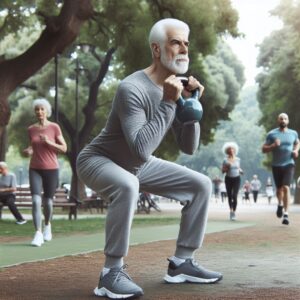
Progression and Adaptation
Gradually increasing the intensity of kettlebell exercises is essential for continued progress. Seniors should start with lighter weights and simpler movements, then advance to heavier weights and more complex exercises. Adapting the routine to individual progress helps maintain motivation and prevent plateaus. Here are some tips for progression and adaptation:
- Increase Weight Gradually: Start with a light kettlebell and gradually increase the weight as you build strength.
- Add Repetitions: Increase the number of repetitions for each exercise to challenge your muscles and improve endurance.
- Incorporate New Exercises: Introduce new kettlebell exercises to keep the routine varied and engaging.
Tracking Progress
Monitoring improvements is crucial for staying motivated and assessing the effectiveness of the workout. Seniors can track their progress using journals, apps, or fitness trackers. Recording achievements and setting new goals fosters a sense of accomplishment and encourages consistency. Here are some tips for tracking progress:
- Keep a Workout Journal: Record the details of each workout, including the exercises performed, the weight used, and the number of repetitions. This helps in identifying patterns, tracking improvements, and making necessary adjustments to the routine.
- Use Fitness Apps: Utilize fitness apps to track your workouts, monitor progress, and set new goals. Many apps offer features like workout logs, progress charts, and reminders, making it easier to stay on track.
- Celebrate Milestones: Recognize and celebrate your achievements, no matter how small. Whether it’s lifting a heavier kettlebell or completing an extra set, celebrating milestones boosts motivation and confidence.

Additional Tips for Fall Prevention for Kettlebell Exercises for Seniors
Home Safety Modifications
In addition to kettlebell exercises, seniors should make home safety modifications to reduce fall risks. Installing grab bars, removing tripping hazards, and ensuring adequate lighting are simple yet effective measures. Creating a safe exercise environment at home is equally important. Here are some tips for home safety:
- Install Grab Bars: Place grab bars in key areas such as bathrooms and stairways to provide support and stability.
- Remove Tripping Hazards: Clear pathways of clutter, loose rugs, and electrical cords to prevent tripping.
- Ensure Adequate Lighting: Use bright, non-glare lighting in all areas of the home, especially in hallways and staircases.
Lifestyle Changes
Nutrition and hydration play a significant role in fall prevention. Seniors should maintain a balanced diet rich in vitamins and minerals and stay hydrated to support overall health. Regular physical activity, including walking and stretching, complements kettlebell exercises for seniors. Here are some tips for healthy lifestyle changes:
- Eat a Balanced Diet: Include a variety of fruits, vegetables, lean proteins, and whole grains in your diet to ensure you get essential nutrients.
- Stay Hydrated: Drink plenty of water throughout the day to stay hydrated and support bodily functions.
- Engage in Regular Physical Activity: Incorporate activities like walking, stretching, and yoga into your routine to enhance flexibility and overall fitness.

Community Resources
Local programs and classes for seniors offer valuable support and opportunities for social engagement. Joining a community group or fitness class can provide motivation, guidance, and a sense of belonging. Seniors should explore available resources and take advantage of these opportunities. Here are some tips for finding community resources:
- Join a Fitness Class: Look for local fitness classes specifically designed for seniors. These classes often focus on strength, balance, and flexibility exercises.
- Participate in Community Programs: Many communities offer programs and activities for seniors, such as walking groups, dance classes, and social events.
- Seek Support Networks: Connect with other seniors who share similar fitness goals. Support networks can provide encouragement, accountability, and friendship.
Conclusion
In summary, kettlebell exercises for seniors are a powerful tool for fall prevention. These exercises improve strength, balance, coordination, and flexibility, contributing to overall physical health. By consulting healthcare providers, maintaining proper form, and choosing the right kettlebell, seniors can safely and effectively incorporate kettlebell training into their routine. Additionally, making home safety modifications, adopting healthy lifestyle changes, and utilizing community resources further enhance fall prevention efforts.
Starting a kettlebell journey may seem daunting, but the benefits are well worth the effort. Seniors are encouraged to take the first step, embrace the challenge, and enjoy the rewards of improved health and independence. Share your experiences, tips, and feedback to inspire others and build a supportive community.


